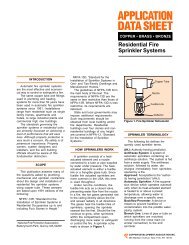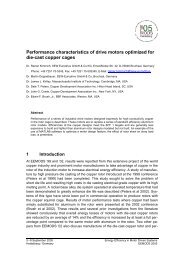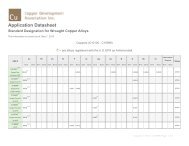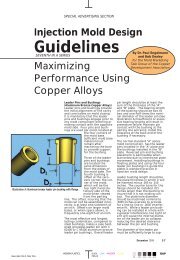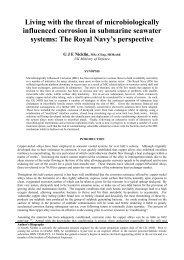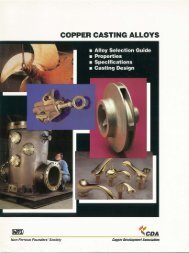Parameters <strong>of</strong> crevice corrosion <strong>in</strong>itiation <strong>and</strong> propagation under frett<strong>in</strong>g <strong>in</strong> <strong>natural</strong> <strong>sea</strong> <strong>water</strong>On the Nibron crevice device, tests beg<strong>in</strong> under a potential <strong>of</strong> -150 mVvs.SCE. As shown <strong>in</strong>Figure 15, currents are ma<strong>in</strong>ta<strong>in</strong>ed low (10 -6 A) for a potential vary<strong>in</strong>g from – 150 mV vsSCE to -100 mV vs SCE. Above these potential, currents become significant from -70 mVvs SCE <strong>and</strong> reach 8. 10 -4 A. Frett<strong>in</strong>g <strong>in</strong>duces no significant <strong>in</strong>crease <strong>in</strong> current. For imposedpotentials from -60 mV vs. SCE to -50 mV vs. SCE, corrosion currents are very high(2.10 -3 A). After the tests, specimen exam<strong>in</strong>ation, presented <strong>in</strong> Figure 16, reveals superficialcorroded areas at the periphery <strong>and</strong> corrosion <strong>in</strong>itiates near the hole but this corrosion hasoccurred dur<strong>in</strong>g the <strong>in</strong>itial immersion phase but not dur<strong>in</strong>g the frett<strong>in</strong>g step.A comparative test conducted on CuNi10Fe1Mn with the results shown on Figure 17 <strong>and</strong>18 leads to the same conclusions with no significant effect <strong>of</strong> the frett<strong>in</strong>g observed. Initiationpotential is estimated around -70 mV vs. SCE under static conditions as under frett<strong>in</strong>g.<strong>Corrosion</strong> areas are also ma<strong>in</strong>ly located at the periphery <strong>of</strong> the specimen.On A45 (see Figure 19), corrosion <strong>in</strong>itiates <strong>natural</strong>ly under free potential ( -105 mV vs.SCE) at the beg<strong>in</strong>n<strong>in</strong>g <strong>of</strong> the test. Under – 100 mV vs. SCE, the current reaches 2. 10 -4 Awhich is higher than those observed on Nibron <strong>and</strong> CuNi10Fe1Mn <strong>in</strong> the same conditions.Under -80 mV vs. SCE, frett<strong>in</strong>g has got an effect on the current measured: after a frett<strong>in</strong>gstep <strong>of</strong> about one hour, corrosion current <strong>in</strong>creases from 4.410 -4 A to 6.2 10 -4 A. From – 70mVvs SCE, the current measured become very high (10 -3 A) but similar under staticconditions <strong>and</strong> under frett<strong>in</strong>g. Specimen exam<strong>in</strong>ation, shown on Figure 20, reveals after thefrett<strong>in</strong>g test a selective corrosion at the periphery <strong>of</strong> the specimen with dealum<strong>in</strong>isation, themaximum corrosion depth be<strong>in</strong>g <strong>of</strong> 0.1 mm.The comparative test conducted on CuAl9Ni3Fe2,<strong>in</strong> Figures 21 <strong>and</strong> 22, leads to similarobservations with lower currents measured. Under -100 mV vs. SCE, the current measuredis <strong>in</strong>deed 9 fold higher on A45. In both cases, A45 <strong>and</strong> CuAl9Ni3Fe2, frett<strong>in</strong>g beg<strong>in</strong>s to beeffective from -80 mV vs SCE with high steady currents that reached respectively 6.2 10 -4A <strong>and</strong> 2.8 10 -3 A. The crevice corrosion test under static conditions previously presented,seems to be less severe with corrosion current measured around 10 -4 A under a potential <strong>of</strong> –100 mV vs.SCE.In conclusion, <strong>in</strong>itiation potentials <strong>in</strong> static conditions <strong>and</strong> under frett<strong>in</strong>g are similar butfrett<strong>in</strong>g could have an effect on corrosion rates especially on A45 <strong>and</strong> CuAl9Ni3Fe2.Globally corrosion <strong>in</strong>itiated <strong>natural</strong>ly dur<strong>in</strong>g the immersion phase <strong>and</strong> propagated underimposed potential essentially out <strong>of</strong> the crevice <strong>in</strong>terface under frett<strong>in</strong>g but also <strong>in</strong> staticconditions.U-bend SCC tests <strong>in</strong> <strong>natural</strong> <strong>sea</strong> <strong>water</strong> <strong>and</strong> polluted <strong>sea</strong> <strong>water</strong> with ammoniaOn A45, cracks <strong>in</strong>itiate <strong>in</strong> <strong>sea</strong> <strong>water</strong> polluted with 1700 ppm <strong>of</strong> ammonia after 1000 hours <strong>of</strong>tests as shown <strong>in</strong> Figures 23 <strong>and</strong> 24, but not <strong>in</strong> <strong>natural</strong> <strong>sea</strong> <strong>water</strong> <strong>and</strong> polluted <strong>sea</strong> <strong>water</strong> with170 ppm <strong>of</strong> ammonia. By comparison, CuAl9Ni3Fe2, suffers from SCC <strong>in</strong> <strong>natural</strong> <strong>sea</strong> <strong>water</strong><strong>and</strong> polluted <strong>sea</strong> <strong>water</strong> with only 170 ppm <strong>of</strong> ammonia. Experimental feedback presentedpreviously [14] had confirmed the susceptibility CuAl9Ni3Fe2 <strong>in</strong> stagnant <strong>sea</strong> <strong>water</strong> <strong>in</strong> longterm service conditions. The test <strong>in</strong> <strong>sea</strong> <strong>water</strong> polluted with ammonia was considered as onepossible simulation <strong>of</strong> SCC phenomenon <strong>in</strong> stagnant <strong>sea</strong> <strong>water</strong>. In that conditions, A45could be considered as susceptible to SCC <strong>in</strong> stagnant <strong>sea</strong> <strong>water</strong> but high concentrations <strong>of</strong>ammonia are needed to reveal its susceptibility compared to CuAl9Ni3Fe2 so that it appearsless critical.6
U-bend tests conducted on Nibron compared to CuNi10Fe1Mn, shown <strong>in</strong> Figures 25 <strong>and</strong> 26has revealed no susceptibility <strong>of</strong> both <strong>alloys</strong> to SCC <strong>in</strong> <strong>natural</strong> <strong>sea</strong> <strong>water</strong> but also <strong>in</strong> stagnant<strong>sea</strong> <strong>water</strong> possibly polluted with ammonia after 5000 hours <strong>of</strong> tests.CONCLUSIONA comparative test campaign was conducted <strong>in</strong> <strong>natural</strong> <strong>sea</strong> <strong>water</strong> <strong>and</strong> polluted <strong>sea</strong> <strong>water</strong> on ahigh strength <strong>copper</strong> nickel alloy (Nibron compared to the classical CuNi10Fe1Mn) <strong>and</strong> aNickel Alum<strong>in</strong>ium Bronzes (A45 compared to CuAl9Ni3Fe2). The follow<strong>in</strong>g conclusionscan be drawn from this study:1. In <strong>natural</strong> <strong>sea</strong> <strong>water</strong> Nibron appears slightly more susceptible to corrosion thanCuNi10Fe1Mn, A45 <strong>and</strong> CuAl9Ni3Fe2 have a similar <strong>behaviour</strong> consider<strong>in</strong>gelectrochemical tests.2. Sulphides pollution leads to a significant <strong>in</strong>crease <strong>in</strong> corrosion on Nibron <strong>and</strong>CuNi10Fe1Mn.3. NH 3 pollution <strong>in</strong>creases the risk <strong>of</strong> SCC on A45 <strong>and</strong> CuAl9Ni3Fe2 as Nibron <strong>and</strong>CuNi10Fe1Mn show no susceptibility to this form <strong>of</strong> corrosion.4. Presence <strong>of</strong> gasket <strong>in</strong>creases the risk <strong>of</strong> crevice corrosion <strong>in</strong>itiation near the gasket but notunder the gasket, phenomenon more over observed <strong>in</strong> operat<strong>in</strong>g conditions.5. Crevice corrosion <strong>in</strong>itiation potentials are similar under static conditions <strong>and</strong> underfrett<strong>in</strong>g. For A45 <strong>and</strong> CuAl9Ni3Fe2, frett<strong>in</strong>g could have an effect on corrosion rates,currents level are higher. Globally, corrosion can <strong>in</strong>itiate <strong>natural</strong>ly dur<strong>in</strong>g the immersionphase <strong>in</strong> <strong>sea</strong> <strong>water</strong> <strong>and</strong> propagate under imposed potential essentially outside <strong>in</strong>terfacespecially under frett<strong>in</strong>g conditions but also <strong>in</strong> static conditions.Globally, the <strong>copper</strong> <strong>alloys</strong> compared have shown rather similar <strong>behaviour</strong>. In <strong>sea</strong> <strong>water</strong>near stagnant conditions, risk <strong>of</strong> corrosion <strong>in</strong>itiation is high with these <strong>alloys</strong> (localisedcorrosion, crevice corrosion close to the gasket, corrosion under deposit, stress corrosioncrack<strong>in</strong>g). Usual recommendations for the use <strong>of</strong> <strong>copper</strong> <strong>alloys</strong> <strong>in</strong> <strong>sea</strong> <strong>water</strong> (ie passivation<strong>in</strong> clean <strong>sea</strong> <strong>water</strong>, suitable range <strong>of</strong> flow rate, biocide treatment) must be strictly followed<strong>in</strong> order to limit localised corrosion.ACKNOWLEDGMENTSThe authors will gratefully acknowledge J Mawella (from MoD) <strong>and</strong> J Galsworthy (fromQ<strong>in</strong>etiq) for support<strong>in</strong>g the French/UK scientist exchange (British French CooperationProgram) which significantly enhanced this study. This work was funded by the FrenchM<strong>in</strong>istry <strong>of</strong> Defence (DGA/DSA/SPN). B. Avaulée <strong>and</strong> E. Postaire are recognised for theirefforts <strong>in</strong> conduct<strong>in</strong>g the tests. The authors also express their appreciation to the wholeDCNS /CETEC/MCP staff for their participation to this work <strong>and</strong> like to thank JM Corrieufrom CESMAN for assistance <strong>in</strong> material chemical analysis <strong>and</strong> mechanical evaluations.REFERENCES1. BC SYRETT, Sulfide attack <strong>in</strong> steam surface condensers, Conf on environmentaldegradation <strong>of</strong> eng<strong>in</strong>eer<strong>in</strong>g materials <strong>in</strong> an aggressive environment, Virg<strong>in</strong>ia PolytechnicInstitute, 19817



